Galileo and the atmosphere of Callisto
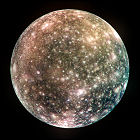 NASA reveals recent findings from the unmanned Galileo orbiter touring Jupiter and its moons, including the discovery of a tenuous atmosphere surrounding the outermost large moon of Jupiter, Callisto. The thin layer of carbon dioxide surrounding Callisto completes the set: Galileo has detected an atmosphere of one kind or another around each of Jupiter’s four Galilean moons, some of which are large enough to be planets. As for how the atmosphere is sustained in the extremely hostile environment around Jupiter, scientists speculate that the CO2 could be emitted from beneath Callisto’s own crust.
NASA reveals recent findings from the unmanned Galileo orbiter touring Jupiter and its moons, including the discovery of a tenuous atmosphere surrounding the outermost large moon of Jupiter, Callisto. The thin layer of carbon dioxide surrounding Callisto completes the set: Galileo has detected an atmosphere of one kind or another around each of Jupiter’s four Galilean moons, some of which are large enough to be planets. As for how the atmosphere is sustained in the extremely hostile environment around Jupiter, scientists speculate that the CO2 could be emitted from beneath Callisto’s own crust.

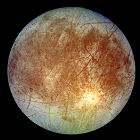 NASA scientists announce a startling find on one of Jupiter’s moons: a chemical which must be manufactured on Earth occurs naturally on the surface of Europa. The Galileo orbiter detects naturally-occurring hydrogren peroxide on the surface of the icy moon (a surface which most planetary scientists now believe covers an ocean of water or “slush” just beneath the crust), probably caused by the constant bombardment of radiation-charged particles from Jupiter itself. The hydrogen peroxide on Europa is also found to be very short-lived, quickly breaking down into gaseous oxygen and hydrogen.
NASA scientists announce a startling find on one of Jupiter’s moons: a chemical which must be manufactured on Earth occurs naturally on the surface of Europa. The Galileo orbiter detects naturally-occurring hydrogren peroxide on the surface of the icy moon (a surface which most planetary scientists now believe covers an ocean of water or “slush” just beneath the crust), probably caused by the constant bombardment of radiation-charged particles from Jupiter itself. The hydrogen peroxide on Europa is also found to be very short-lived, quickly breaking down into gaseous oxygen and hydrogen.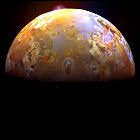 NASA/JPL’s unmanned Galileo space probe buzzes Jupiter’s volcanically active moon Io, zipping directly over one of its most active volcanic regions at an altitude of only 380 miles, Galileo’s closest Io flyby to date. But this close encounter, and the fate of Galileo itself, had been in doubt just hours before the flyby: entering Jupiter’s most intense radiation environment, Galileo had entered a failsafe mode in which the spacecraft shuts down until further commands are received from Earth. Ground controllers, called in to work emergency hours on a Sunday, revive Galileo a mere two hours before its close pass by Io.
NASA/JPL’s unmanned Galileo space probe buzzes Jupiter’s volcanically active moon Io, zipping directly over one of its most active volcanic regions at an altitude of only 380 miles, Galileo’s closest Io flyby to date. But this close encounter, and the fate of Galileo itself, had been in doubt just hours before the flyby: entering Jupiter’s most intense radiation environment, Galileo had entered a failsafe mode in which the spacecraft shuts down until further commands are received from Earth. Ground controllers, called in to work emergency hours on a Sunday, revive Galileo a mere two hours before its close pass by Io.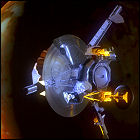 Completing its extended two-year tour of Jupiter and its intriguing moons Io and Europa, NASA’s Galileo robotic probe is given another extension, this time called the Galileo Millennium Mission. Highlights are expected to include observing Jupiter in tandem with the Cassini unmanned probe, which will swing by Jupiter in 2000 to gain a gravity assist en route to its own final target, Saturn. Galileo will also resume its exploration of the major Jovian moon Ganymede, the solar system’s largest satellite.
Completing its extended two-year tour of Jupiter and its intriguing moons Io and Europa, NASA’s Galileo robotic probe is given another extension, this time called the Galileo Millennium Mission. Highlights are expected to include observing Jupiter in tandem with the Cassini unmanned probe, which will swing by Jupiter in 2000 to gain a gravity assist en route to its own final target, Saturn. Galileo will also resume its exploration of the major Jovian moon Ganymede, the solar system’s largest satellite.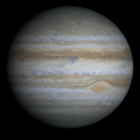 NASA’s Cassini space probe successfully completes a slingshot maneuver past Jupiter, a necessary milestone on the unmanned robot’s long journey to Saturn. While in the neighborhood, Cassini conducts tandem studies of Jupiter with the still-operational Galileo probe, which – despite numerous major malfunctions – has still survived three years longer in Jovian space than it was expected to. As large as Jupiter is, Cassini will still be lending its electronic eyes and ears to studies of the largest planet well into January. Cassini will reach Saturn’s neighborhood in 2004.
NASA’s Cassini space probe successfully completes a slingshot maneuver past Jupiter, a necessary milestone on the unmanned robot’s long journey to Saturn. While in the neighborhood, Cassini conducts tandem studies of Jupiter with the still-operational Galileo probe, which – despite numerous major malfunctions – has still survived three years longer in Jovian space than it was expected to. As large as Jupiter is, Cassini will still be lending its electronic eyes and ears to studies of the largest planet well into January. Cassini will reach Saturn’s neighborhood in 2004.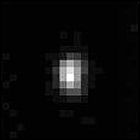 NASA releases a photo taken by the Cassini space probe as it passed by Jupiter and its complex system of satellites in December 2000, showing the first-ever view of the tiny moon Himalia, taken from a distance of 2.7 million miles. Non-spherical in shape, but estimated to be roughly 100 miles across its widest face, Himalia is believed to be an asteroid permanently captured into an inclined orbit of Jupiter. It was discovered in 1904 from Earth-based telescopes. The New Horizons space probe will also attempt to image Himalia in 2007. The sixth largest satellite of Jupiter, Himalia is the first of the planet’s outer satellites beyond the orbit of Callisto to be photographed by a passing spacecraft.
NASA releases a photo taken by the Cassini space probe as it passed by Jupiter and its complex system of satellites in December 2000, showing the first-ever view of the tiny moon Himalia, taken from a distance of 2.7 million miles. Non-spherical in shape, but estimated to be roughly 100 miles across its widest face, Himalia is believed to be an asteroid permanently captured into an inclined orbit of Jupiter. It was discovered in 1904 from Earth-based telescopes. The New Horizons space probe will also attempt to image Himalia in 2007. The sixth largest satellite of Jupiter, Himalia is the first of the planet’s outer satellites beyond the orbit of Callisto to be photographed by a passing spacecraft.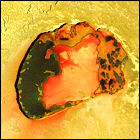 NASA/JPL’s Galileo unmanned space probe makes the closest flybys yet of Io, the volcanically hyperactive moon of Jupiter which made headlines when Voyager scientists spotted an eruption in 1980. The new images give the best view yet of Io’s inhospitable surface, including a volcanic crater, 47 miles across, named after the Brazilian god of thunder, Tupan Patera – an eye-searingly colorful region even in natural light.
NASA/JPL’s Galileo unmanned space probe makes the closest flybys yet of Io, the volcanically hyperactive moon of Jupiter which made headlines when Voyager scientists spotted an eruption in 1980. The new images give the best view yet of Io’s inhospitable surface, including a volcanic crater, 47 miles across, named after the Brazilian god of thunder, Tupan Patera – an eye-searingly colorful region even in natural light.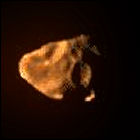 Nearing the end of its fuel supply, NASA’s Galileo probe passes one of Jupiter’s innermost moons, tiny, asteroid-like Amalthea, at a distance of less than 100 miles, coming closer to Jupiter and its belts of intense radiation than ever before. This final flyby of a Jovian moon is a punishing one for Galileo: the failure of Galileo’s main antenna dish after its 1989 launch has forced the robotic explorer to store its findings on tape for later playback to Earth at a low bit rate, but in this case roughly half of Galileo’s measurements of the highly charged environment near Jupiter are lost to radiation-induced failure of the tape recording system. The intense radiation also causes enough faults in Galileo’s main computer that the probe puts itself in a failsafe mode and “sleeps” until further commands are received from Earth hours later.
Nearing the end of its fuel supply, NASA’s Galileo probe passes one of Jupiter’s innermost moons, tiny, asteroid-like Amalthea, at a distance of less than 100 miles, coming closer to Jupiter and its belts of intense radiation than ever before. This final flyby of a Jovian moon is a punishing one for Galileo: the failure of Galileo’s main antenna dish after its 1989 launch has forced the robotic explorer to store its findings on tape for later playback to Earth at a low bit rate, but in this case roughly half of Galileo’s measurements of the highly charged environment near Jupiter are lost to radiation-induced failure of the tape recording system. The intense radiation also causes enough faults in Galileo’s main computer that the probe puts itself in a failsafe mode and “sleeps” until further commands are received from Earth hours later.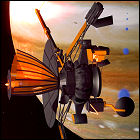 NASA and JPL ground controllers coax the radiation-damaged tape recorder built into the Galileo probe into working again, finally allowing several weeks worth of scientific data to be replayed to Earth. The damage was suffered during Galileo’s closest pass by Jupiter to study the tiny moon Amalthea the previous month. With layoffs looming for many of Galileo’s ground control staff in early 2003, this is Galileo’s last chance to relay its scientific findings back to Earth. It is on a trajectory that will end its mission by plunging into Jupiter in 2003.
NASA and JPL ground controllers coax the radiation-damaged tape recorder built into the Galileo probe into working again, finally allowing several weeks worth of scientific data to be replayed to Earth. The damage was suffered during Galileo’s closest pass by Jupiter to study the tiny moon Amalthea the previous month. With layoffs looming for many of Galileo’s ground control staff in early 2003, this is Galileo’s last chance to relay its scientific findings back to Earth. It is on a trajectory that will end its mission by plunging into Jupiter in 2003.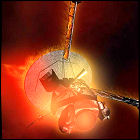 The mission of the unmanned space probe Galileo ends in the clouds of the giant planet Jupiter, which it has orbited for eight years. Even as Galileo plunges toward Jupiter, it detects and reports evidence of a thin ring sharing the orbit of the small moon Amalthea, and then disintegrates as it falls into Jupiter. NASA has opted to send Galileo to its destruction, rather than risking a collision with Europa, which may harbor some of the ingredients necessary for life and might be contaminated if Galileo impacted it; Galileo’s mission was extended three times, with the vehicle lasting six years longer than anticipated in the original mission plan’s estimates, which included for the harsh radiation environment of Jupiter as a factor in expecting only a two-year mission.
The mission of the unmanned space probe Galileo ends in the clouds of the giant planet Jupiter, which it has orbited for eight years. Even as Galileo plunges toward Jupiter, it detects and reports evidence of a thin ring sharing the orbit of the small moon Amalthea, and then disintegrates as it falls into Jupiter. NASA has opted to send Galileo to its destruction, rather than risking a collision with Europa, which may harbor some of the ingredients necessary for life and might be contaminated if Galileo impacted it; Galileo’s mission was extended three times, with the vehicle lasting six years longer than anticipated in the original mission plan’s estimates, which included for the harsh radiation environment of Jupiter as a factor in expecting only a two-year mission.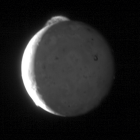 NASA’s New Horizons probe, on a one-way trip to become the first probe to swing past distant Pluto, picks up speed dramatically as it slingshots past Jupiter. New Horizons sensors are trained on the giant planet to get the first look at Jupiter since Galileo swan-dived into its crushing atmosphere. New Horizons gains nearly 9,000 miles per hour as it swings past Jupiter, which will put it at Pluto in July 2015. New Horizons’ camera catches an erupting volcano on Jupiter’s moon Io, spewing material 200 miles above the surface.
NASA’s New Horizons probe, on a one-way trip to become the first probe to swing past distant Pluto, picks up speed dramatically as it slingshots past Jupiter. New Horizons sensors are trained on the giant planet to get the first look at Jupiter since Galileo swan-dived into its crushing atmosphere. New Horizons gains nearly 9,000 miles per hour as it swings past Jupiter, which will put it at Pluto in July 2015. New Horizons’ camera catches an erupting volcano on Jupiter’s moon Io, spewing material 200 miles above the surface.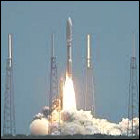 NASA launches the unmanned Juno space probe on its way to Jupiter, on a trajectory that will accelerate the vehicle through a series of maneuvers, including a gravity assist pass of Earth, en route to Jupiter. Once it arrives at the solar system’s largest planet, Juno will enter a polar orbit to monitor the planet’s clouds and magnetic field over a period of one year beginning in 2016. Juno is solar-powered, without the customary nuclear power source that has been a feature of all previous outer solar system missions. Since it will spend time within the heaviest area of Jupiter’s magnetosphere, Juno’s components are built into a hexagonal structure which acts as a heavy-duty Faraday cage to block out the radiation trapped within Jupiter’s magnetic field.
NASA launches the unmanned Juno space probe on its way to Jupiter, on a trajectory that will accelerate the vehicle through a series of maneuvers, including a gravity assist pass of Earth, en route to Jupiter. Once it arrives at the solar system’s largest planet, Juno will enter a polar orbit to monitor the planet’s clouds and magnetic field over a period of one year beginning in 2016. Juno is solar-powered, without the customary nuclear power source that has been a feature of all previous outer solar system missions. Since it will spend time within the heaviest area of Jupiter’s magnetosphere, Juno’s components are built into a hexagonal structure which acts as a heavy-duty Faraday cage to block out the radiation trapped within Jupiter’s magnetic field.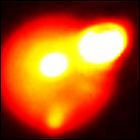 Astronomers using the Keck Observatory’s Hawaii-based telescopes and near-infrared cameras capture an image of a devastating volcanic eruption on Io, one of Jupiter’s largest moons (and known since 1979 to be very volcanically active). The eruption, unleashing enough molten material to reshape hundreds of square miles of Io’s surface, also reveals that the material erupted is hotter than any eruption in Earth’s recorded history. This is the most violent eruption seen to date in the solar system, and caps off two weeks of intense activity observed by the astronomers.
Astronomers using the Keck Observatory’s Hawaii-based telescopes and near-infrared cameras capture an image of a devastating volcanic eruption on Io, one of Jupiter’s largest moons (and known since 1979 to be very volcanically active). The eruption, unleashing enough molten material to reshape hundreds of square miles of Io’s surface, also reveals that the material erupted is hotter than any eruption in Earth’s recorded history. This is the most violent eruption seen to date in the solar system, and caps off two weeks of intense activity observed by the astronomers.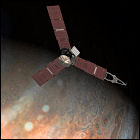 NASA’s Juno space probe successfully pulls of a risky orbital insertion maneuver, slowing itself down just enough to be captured into an unprecedented polar orbit around Jupiter. Launched in 2011, Juno’s first close pass of Jupiter brings it within 3,100 miles of Jupiter’s cloudtops, the closest any spacecraft has ever approached the huge planet. Its polar orbit will allow it to reduces its exposure to Jupiter’s intense magnetic field, which is powerful enough in the planet’s equatorial regions to damage or destroy on-board electronics. Juno’s mission is expected to last 20 months.
NASA’s Juno space probe successfully pulls of a risky orbital insertion maneuver, slowing itself down just enough to be captured into an unprecedented polar orbit around Jupiter. Launched in 2011, Juno’s first close pass of Jupiter brings it within 3,100 miles of Jupiter’s cloudtops, the closest any spacecraft has ever approached the huge planet. Its polar orbit will allow it to reduces its exposure to Jupiter’s intense magnetic field, which is powerful enough in the planet’s equatorial regions to damage or destroy on-board electronics. Juno’s mission is expected to last 20 months.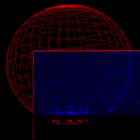 NASA’s Juno spacecraft completes its first orbit of giant planet Jupiter with an orbit-shaping manever that takes it as close to Jupiter’s cloudtops as 2,600 miles – less than the width of the continental United States – at a speed of over 100,000 miles per hour. Juno obtains the first close-up views of the north and south poles of the planet, revealing a roiling hotbed of storm activity unlike the poles of relatively quiet Saturn. In addition to photos, Juno scans the planet in the infrared and ultraviolet portions of the spectrum. This is scheduled to be Juno’s closest flyby of its entire mission.
NASA’s Juno spacecraft completes its first orbit of giant planet Jupiter with an orbit-shaping manever that takes it as close to Jupiter’s cloudtops as 2,600 miles – less than the width of the continental United States – at a speed of over 100,000 miles per hour. Juno obtains the first close-up views of the north and south poles of the planet, revealing a roiling hotbed of storm activity unlike the poles of relatively quiet Saturn. In addition to photos, Juno scans the planet in the infrared and ultraviolet portions of the spectrum. This is scheduled to be Juno’s closest flyby of its entire mission.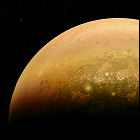 NASA’s Juno space probe makes a third close swing past Jupiter, but engineering problems make it a blind pass: concerns over stuck valves in the engine leads ground controllers to cancel a planned engine burn to shorten the length of Juno’s orbit, and then mere hours before its latest close pass, Juno goes into a safe mode which shuts down all instruments and cameras pending intervention from Earth. Juno principal investigator Scott Bolton assures that Juno could, theoretically, complete its mission with longer, unadjusted orbits if need be; Juno’s next close pass by Jupiter is expected to happen in December, impacting all future events in the mission plan.
NASA’s Juno space probe makes a third close swing past Jupiter, but engineering problems make it a blind pass: concerns over stuck valves in the engine leads ground controllers to cancel a planned engine burn to shorten the length of Juno’s orbit, and then mere hours before its latest close pass, Juno goes into a safe mode which shuts down all instruments and cameras pending intervention from Earth. Juno principal investigator Scott Bolton assures that Juno could, theoretically, complete its mission with longer, unadjusted orbits if need be; Juno’s next close pass by Jupiter is expected to happen in December, impacting all future events in the mission plan.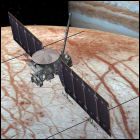 After a long process of gaining sufficient approval to be budgeted for a design phase, NASA’s Europa Clipper spacecraft gets a name and a preliminary shape, but no completion date or launch window any more specific than “the 2020s”, likely putting it at Jupiter’s intriguing moon Europa in the early 2030s after a series of gravity assists. Europa Clipper is intended to closely survey Europa from orbit, attempting to focus on its icy surface and the saltwater ocean believed to be hidden beneath that surface.
After a long process of gaining sufficient approval to be budgeted for a design phase, NASA’s Europa Clipper spacecraft gets a name and a preliminary shape, but no completion date or launch window any more specific than “the 2020s”, likely putting it at Jupiter’s intriguing moon Europa in the early 2030s after a series of gravity assists. Europa Clipper is intended to closely survey Europa from orbit, attempting to focus on its icy surface and the saltwater ocean believed to be hidden beneath that surface.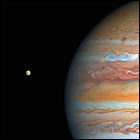 NASA and ESA announce that spectrographic analysis of Hubble Space Telescope data gathered during observations of Jupiter’s icy moon Europa reveals that Europa has a persistent atmosphere of water vapor, but only on the hemisphere of the moon that is opposite of the direction of its orbital motion. (This unusual effect had been predicted in computer modeling, but had not been directly observed until now.) The atmosphere is present in Hubble spectroscopy data as old as 1999 and as recent as 2015. The stability of the water vapor in the atmosphere is the real surprise find, since surface-based water was assumed to be in solid ice form.
NASA and ESA announce that spectrographic analysis of Hubble Space Telescope data gathered during observations of Jupiter’s icy moon Europa reveals that Europa has a persistent atmosphere of water vapor, but only on the hemisphere of the moon that is opposite of the direction of its orbital motion. (This unusual effect had been predicted in computer modeling, but had not been directly observed until now.) The atmosphere is present in Hubble spectroscopy data as old as 1999 and as recent as 2015. The stability of the water vapor in the atmosphere is the real surprise find, since surface-based water was assumed to be in solid ice form.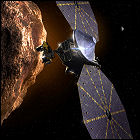 NASA launches the Lucy spacecraft on its twelve-year mission to study select specimens of the Trojan asteroid swarms that both precede and trail the planet Jupiter at the stable LaGrange points in its orbit. Lucy’s complex trajectory calls for it to conduct gravity assist flybys of Earth in 2022 and 2024, and to survey the main asteroid belt body 52246 Donaldjohanson in 2025, en route to reaching its first Trojan asteroid, 3548 Eurybates, in 2027. Future targets include 15094 Polymele later in 2027, 11351 Leucus and 21900 Orus in 2028, and – after a further gravity assist flyby of Earth in 2030 – the binary Trojan pair 617 Patroclus-Menoetius in 2033. Lucy’s name is not an abbreviation; it is named after a famous fossil skeleton discovered in 1971 by a team led by anthropologist David Johanson; it is hoped that studying the Trojan asteroids will lead to discoveries that make them similar “missing links” in the solar system’s own fossil record.
NASA launches the Lucy spacecraft on its twelve-year mission to study select specimens of the Trojan asteroid swarms that both precede and trail the planet Jupiter at the stable LaGrange points in its orbit. Lucy’s complex trajectory calls for it to conduct gravity assist flybys of Earth in 2022 and 2024, and to survey the main asteroid belt body 52246 Donaldjohanson in 2025, en route to reaching its first Trojan asteroid, 3548 Eurybates, in 2027. Future targets include 15094 Polymele later in 2027, 11351 Leucus and 21900 Orus in 2028, and – after a further gravity assist flyby of Earth in 2030 – the binary Trojan pair 617 Patroclus-Menoetius in 2033. Lucy’s name is not an abbreviation; it is named after a famous fossil skeleton discovered in 1971 by a team led by anthropologist David Johanson; it is hoped that studying the Trojan asteroids will lead to discoveries that make them similar “missing links” in the solar system’s own fossil record.